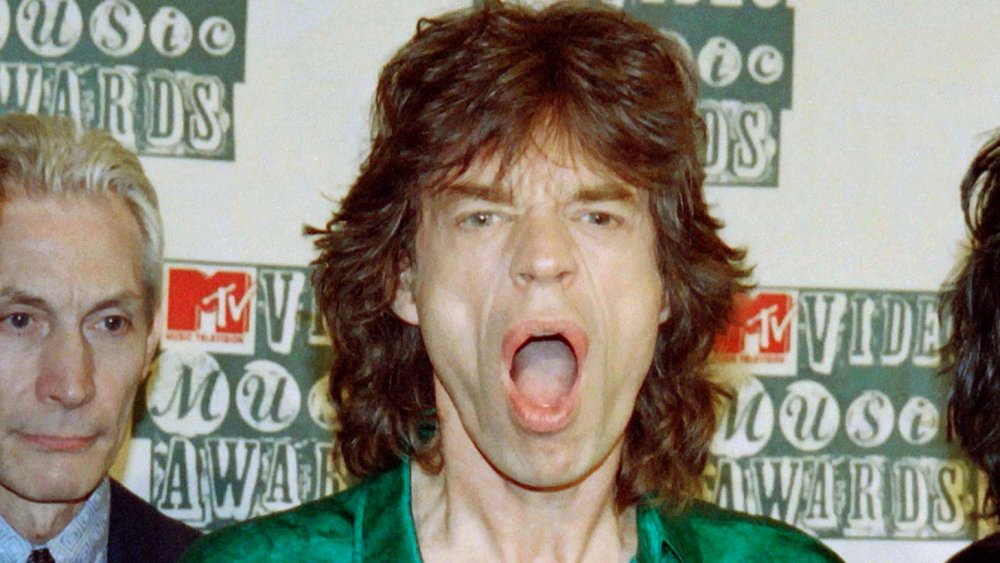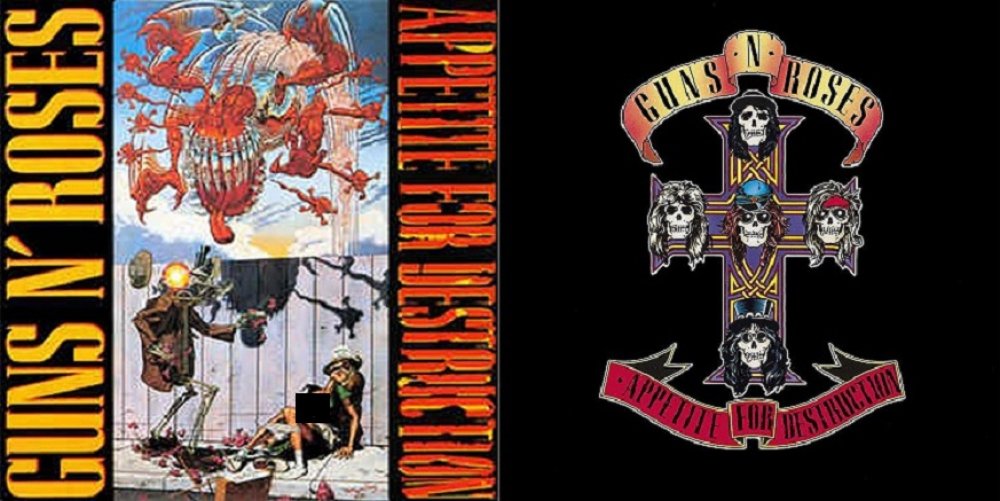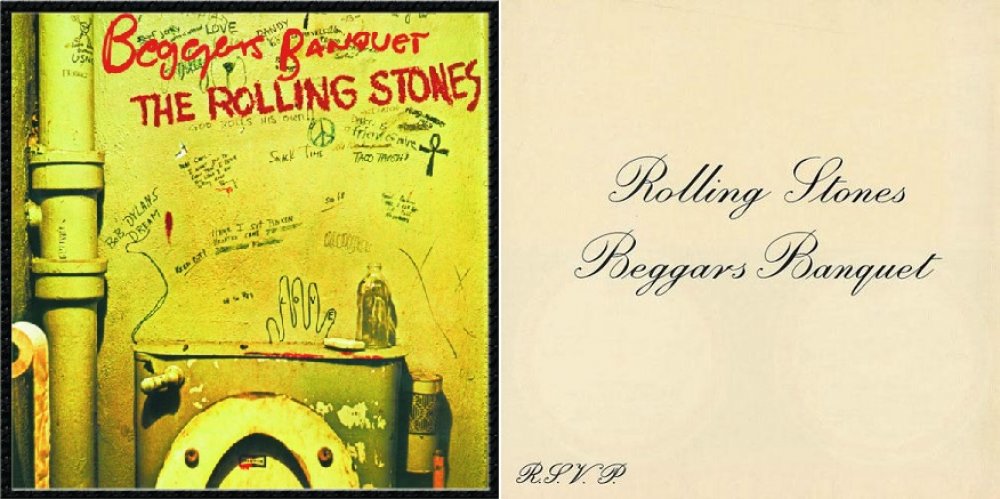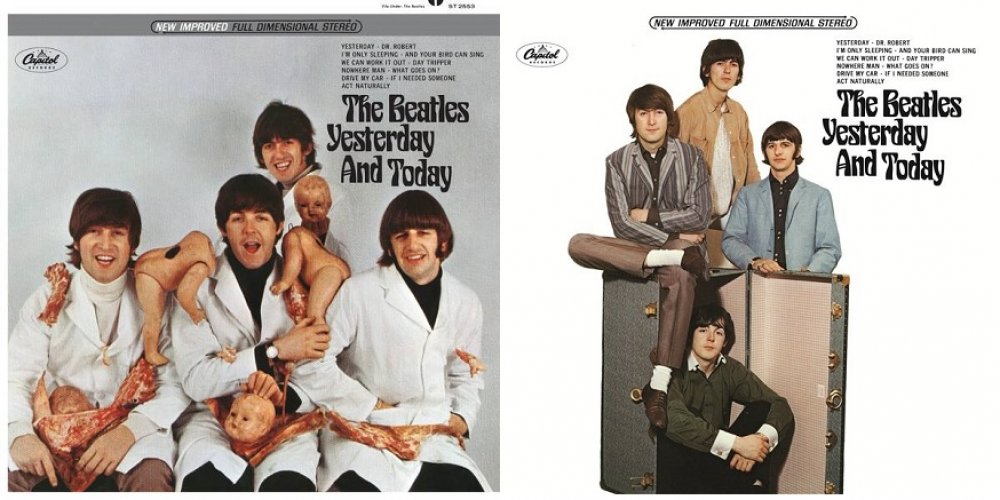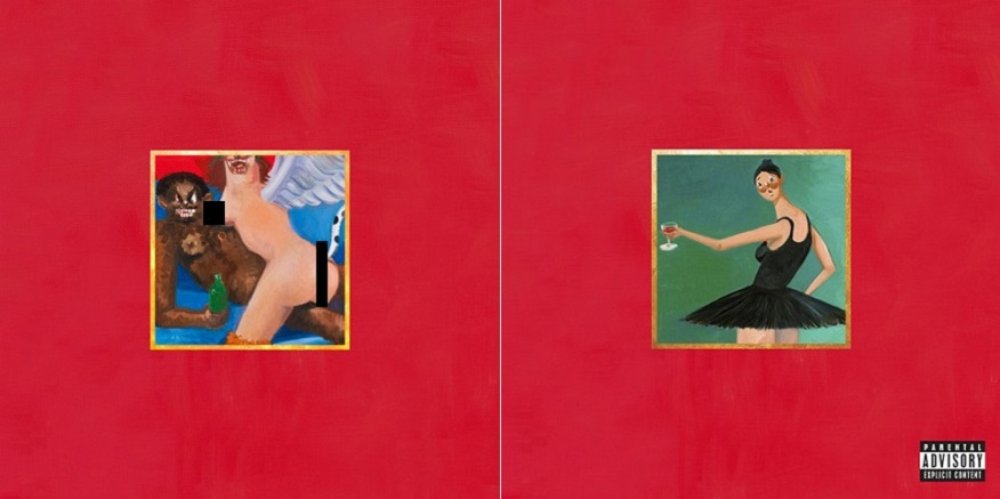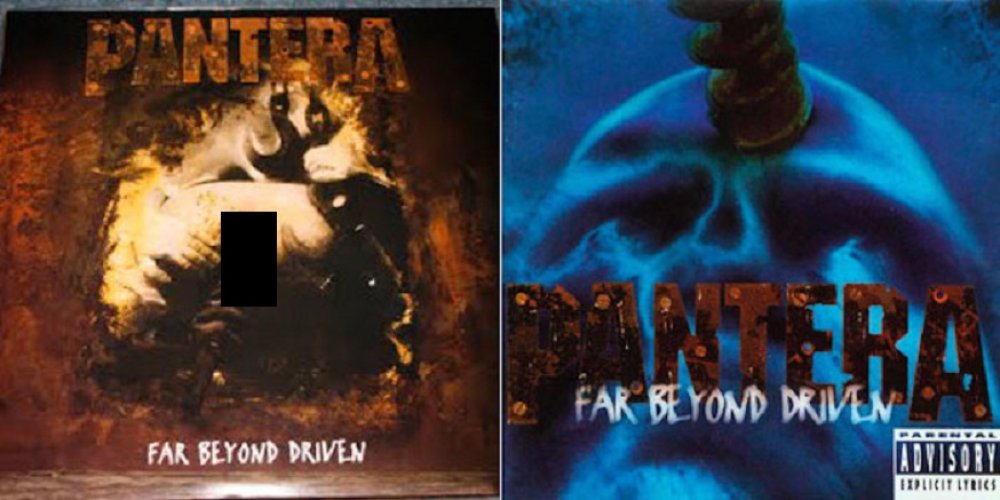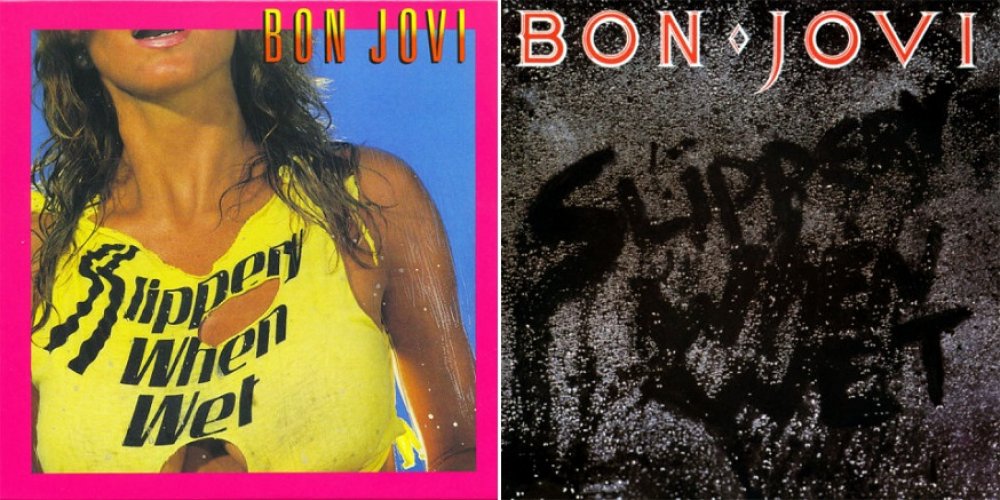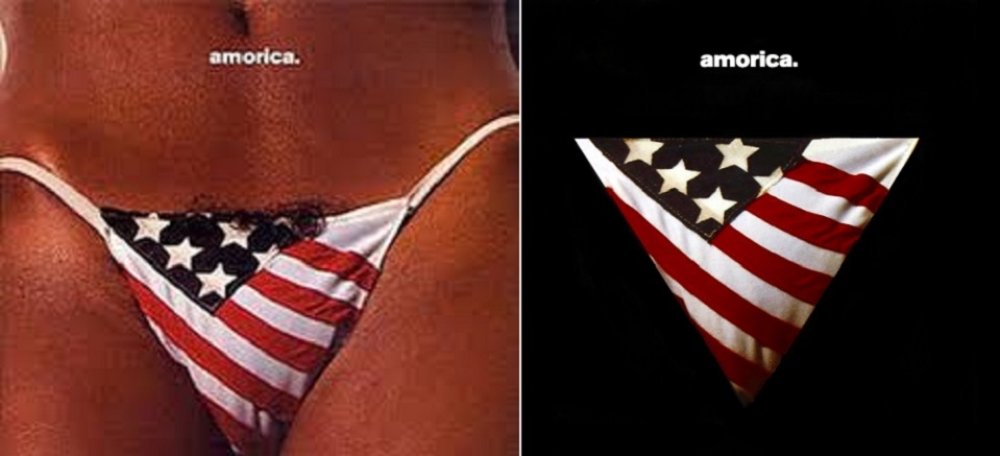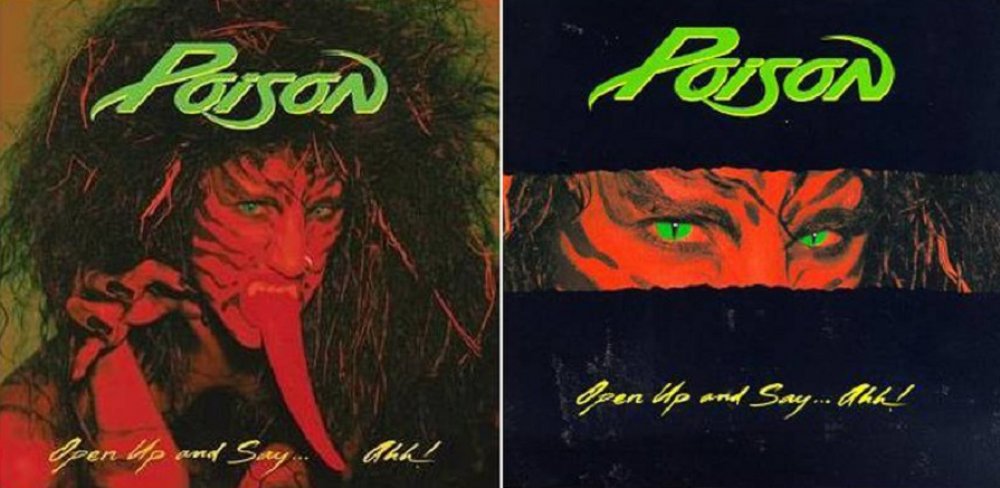Musicians That Were Forced To Change Their Album Covers
Making an album is a huge, costly, time-consuming endeavor for solo artists and bands alike. First, they have to write the songs, then they spend months in a recording studio to make perfect, definitive masters of those songs. Then it's all mixed and engineered and — depending on the era in which it was made — committed to countless vinyl records, cassette tapes, compact discs, or streaming services.
But just because the music is done, that doesn't mean the album is ready for public consumption. Every album needs a cover, some kind of eye-catching art that describes the feeling of the music inside. However, sometimes musicians choose art that just won't fly, picking or commissioning a photo or a painting that features nudity, violence, or any number of other things that may offend large swaths of people. And so, record labels force a change, even with major acts who earn tens of millions of dollars. From heavy metal mishaps to British Invasion blunders, here are some times when musicians were forced to change their album covers.
Guns N' Roses kept the name, ditched the art
Released in 1987, Guns N' Roses' Appetite for Destruction is the bestselling debut album in rock history. More than 18 million people bought the iconic hard rock record with its iconic cover — a cross adorned with the faces of the band's five members but in skull form, which is very metal. In fact, it's almost as metal as standout tracks like "Paradise City" and "Welcome to the Jungle."
However, neither that cover nor any song on Appetite for Destruction comes close to reaching the oh-so-metal heights of the first stab at the cover — the 1978 painting Appetite for Destruction by artist Robert Williams. It depicts a semi-nude woman in the midst of a gruesome assault by a robot with a bear trap for a head, while a giant beast lurks overhead, shooting off red skulls-and-crossbones and rocking a bunch of daggers on what's probably its head. Prior to the album's release, Williams predicted trouble. "I suggested that they come over to my house and look through some slides and pick something for the cover, because I knew they were gonna get in trouble with it," he told Revolver (via Rolling Stone). Indeed, many chain stores refused to stock Appetite for Destruction in that form. The band's label, Geffen, told the group to try again, so they hired artist Billy White Jr., who came up with the approved cover.
The Rolling Stones had to can this concept
Back when they were starting out in the 1960s, the Rolling Stones were kind of the dangerous bad boys of the British Invasion, contrary to the relatively innocent Beatles. While the pre-drug-influenced Beatles sang songs about needing help and holding hands, the Rolling Stones played sleazy blues-inspired riffs as lead singer Mick Jagger predatorily strutted around the stage, demanding "Satisfaction."
In 1968, the group released Beggars Banquet, an album which starts off with the provocative "Sympathy for the Devil." But that wasn't the big problem with the LP. Instead, the first cover really upset some people. Beggars Banquet was supposed to have a foldout cover (designed by Tom Wilkes) bearing the image (from photographer Barry Feinstein) of a graffiti-laden public bathroom wall. The release was delayed for months because higher-ups at the Stones' label, London Records, balked. The reason? Bathroom imagery in 1968 was just too suggestive. When Beggars Banquet finally hit record stores, it came in a plain white sleeve with the name of the band and the record's title written in a simple script font.
Meat, the Beatles
In 1966, Capitol Records threw together a bunch of Beatles tracks for a compilation called Yesterday and Today, notable primarily for its original, bizarre cover. Earlier in 1966, the Fab Four sat for a session with rock photographer Robert Whitaker for an avant garde art piece he called Somnambulant Adventure. Whitaker dressed up the Beatles in butcher smocks, then covered them in meat and baby doll parts. (Hey, it was the '60s.) The Beatles so liked one of Whitaker's photos that they handed it over when Capitol asked them to provide cover art for Yesterday and Today. Label head Alan Livingston freaked out. "I looked at it and thought, 'What in the hell is this? How can I put this out?'" he later told Mojo (via Rolling Stone). "I showed it to our sales manager and a few other people, and they turned green." Paul McCartney refused to reconsider, arguing that the photo constituted anti-Vietnam War commentary.
Nevertheless, Capitol printed 750,000 Yesterday and Today sleeves in anticipation of a June 15, 1966 release date, sending some out to stores beforehand. "Word came back very fast that the dealers would not touch it. They would not put the album in their stores," Livingston said. Faced with that reality, the Beatles relented, and on June 14 — the day before the album's release date — Capitol recalled the LP. Most were retrieved, but a few were sold, making an original "butcher" copy of Yesterday and Today a valuable collector's item.
Getting this to stores was a beautiful, dark, twisted fantasy
From his beef with Taylor Swift to releasing operas, Kanye West seems to do whatever he likes. Back in 2010, however, the future Mr. Kardashian stepped over the line with his label, the Island Def Jam Music Group. On October 17 of that year, West tweeted that he was adding the last bits to My Beautiful Dark Twisted Fantasy before its scheduled November release. Later that day, West announced via Twitter that his label "banned my album cover!!!!!" from an American release. The rapper subsequently shared that supposedly cursed image — an illustration by artist George Condo of a naked West hanging out on a blue couch, with a naked, armless angel/woman hybrid with a polka dot tail sitting astride his lap.
According to an anonymous Island Def Jam source in a Los Angeles Times report, the label greatly persuaded West to use a different picture, but if he wanted to use his original pick, "the label would stand behind him." That Island Def Jam source added that the company was afraid such graphic imagery would lead to stores like Best Buy and Walmart refusing to stock the CD. Condo later told the The New Yorker that West actually wanted a ban, as it would be an effective publicity stunt to drive sales. While Walmart ultimately had no problem with the cover, other stores did, and they stocked an alternate version of My Beautiful Dark Twisted Fantasy, bearing the image of a ballet dancer.
Far beyond permissible
Pantera was always unabashedly metal. The Dallas-based band, fronted by singer Phil Anselmo and driven by the guitar work of the late "Dimebag" Darrell Abbott, brought an earth-shaking metal assault to mainstream rock radio in the early '90s, a counterpoint to the hair bands and grunge bands most associated with the era. In 1994, Pantera's Far Beyond Driven became an unlikely No. 1 hit on the Billboard album chart, featuring both the hit single "I'm Broken" and one of the most metal album covers ever — an almost impressionistic rendering of a massive drill bit boring into the front of a human skull.
And to think, this wasn't Pantera's first choice for the cover art. It replaced something even more audacious. The original cover featured a drill, but it was going into the other end of a human being. (The rear end. Literally.) "The original thought was 'metal up your a**,' you know?" Pantera drummer Vinnie Paul told Vanyaland in 2014, before adding, "In 1994, heavy metal was uncool, and we wanted to be as metal as we could." Three days after submitting artist Dean Karr's design to EastWest Records, a rep told them it would preclude the album from getting placement in major retailers like Target and Walmart. The band asked Karr to try again, with Paul later explaining, "And he did the one with the drill in the head which signifies the same thing."
Album covers are a slippery slope for Bon Jovi
For millions, the '80s were a sleazy time, defined by the loud, hard-partying, and degenerate ways of bands like Motley Crüe, Whitesnake, and Bon Jovi. Formed in the early '80s in New Jersey as a pop rock band, Bon Jovi evolved into one of the era's quintessential, radio-friendly "hair metal" acts, heaping on the hair product but also catchy hooks in songs like "Livin' on a Prayer" and "You Give Love a Bad Name."
Both of those tunes appear on Bon Jovi's third album and commercial breakthrough, Slippery When Wet. Proving their '80s sleaze bona fides, the band got the LP name after visiting a Vancouver strip club that featured dancers showering on stage. It behooved these musicians, then, to represent that vibe on the album cover. Slippery When Wet initially came in a sleeve featuring a picture of a model in a T-shirt bearing the words "slippery when wet," and that T-shirt was soaking wet and laden with strategically placed holes. Anticipating that big stores might not carry an album with such an explicit cover, Mercury Records made the band change the sleeve just before the album's August 1986 for-sale date. The one that went to the printer featured a moist black garbage bag adorned with the record's title.
Lynyrd Skynyrd flames out
Few bands were as popular — or enjoyed as loyal of a following — as Lynyrd Skynyrd. Between 1973 and 1976, the quintessential Southern rock band produced four albums that sold millions of copies and generated songs still heard all day long on classic rock radio, especially "Sweet Home Alabama" and "Free Bird." The group's fifth album is its highest-charting, as Street Survivors reached No. 5 on the Billboard album chart in 1977 thanks to hits like "What's Your Name" and "That Smell." Sadly, it was all in the wake of one of the saddest tragedies in rock history.
Just days after Street Survivors hit stores in October 1977, Lynyrd Skynyrd was in the middle of a tour in support of the album. On a flight from Greenville, South Carolina, to Baton Rouge, Louisiana, the band's small charter plane ran out of fuel. An emergency landing failed, and the aircraft crashed in a wooded area in Mississippi. Both pilots died upon impact, as did lead singer Ronnie Van Zant, guitarist Steve Gaines, backup singer Cassie Gaines, and assistant road manager Dean Kilpatrick. MCA Records responded by pulling Street Survivors from stores and reissuing it with a new cover. After the plane crash, the original art seemed tasteless and sad, as it involved a wide shot of the group in front of a backdrop of flames. MCA removed the fire and used a different shot of the band from the same photo shoot.
A Marvel-ous switch for Joe Satriani
Joe Satriani's career is full of exceptions to the rule. When he broke through in 1987 with his second album, Surfing with the Alien, instrumental rock music was a niche genre, decades removed from its peak in the '60s, the age of lyric-free hits like "Pipeline" and "Tequila." But here came Satriani, an electric guitar virtuoso who didn't need a singer to propel his hard rock up the charts. Surfing with the Alien hit No. 29 on the Billboard album charts, while the title track and "Satch Boogie" both performed well on the mainstream rock chart.
Surfing with the Alien was reissued in 2019 in a small run of just 3,500 copies for Record Store Day's Black Friday event. But this time, it featured an entirely new cover, with an artistic rendering of the headstock of Satriani's guitar. Gone was the LP's original, familiar album art that was a literal interpretation of the title, using the Silver Surfer of Marvel Comics fame. But what was the reason for the change? Well, with the rise of Marvel as a lucrative, Disney-owned, billions-generating commercial phenomenon, it's a lot more expensive to grab an image of one of its heroes in 2019 than it was in 1987. "Due to the ever increasing costs of licensing the Silver Surfer artwork from Marvel, we were forced to come up with a new cover," Satriani said in a statement (via Ultimate Classic Rock).
This is Amorica
Nobody else in the early '90s sounded quite like the Black Crowes. Led by the raspy voiced Chris Robinson, the band would've been more at home in the early '70s alongside Lynyrd Skynyrd. After all, the group combined blues, Southern rock, and hard rock to create its own unique flavor that propelled it upward. As a result, Shake Your Money Maker went quintuple platinum, and the follow-up, The Southern Harmony and Musical Companion, hit No. 1 in the U.S.
So naturally, the Black Crowes' third album, 1994's Amorica, was hotly anticipated, although the first choice of cover art invited some momentum-killing controversy. Amorica initially shipped bearing an image pulled from a 1976 issue of Hustler. It was an image of a female nether region, clad in American-flag bikini bottoms, with pubic hair creeping out. Several major Amorican, sorry, American retailers flat-out refused to stock such a suggestively decorated album, and a few big publications wouldn't run ads for the album. The Black Crowes label, American Recordings, offered an alternative cover, with the Old Glory swimsuit against a completely black background. Amidst cries of censorship, Robinson told the New York Post (via Billboard) that he was okay with the second cover because "some of the stores that don't want to carry" Amorica "are the only record stores in some of these towns." He then went on to say, "I want the kids who like the Black Crowes to be able to get the record."
Open up and say...nothing
The 1980s weren't that long ago, but in retrospect, it was a very conservative time. Tipper Gore's Parents Music Resource Center (PMRC) pressured the recording industry into slapping warning labels onto albums with "explicit lyrics," and some of the edgier acts of the time — particularly hard rock and metal bands — found themselves under intense scrutiny. For example, Poison's second album, 1988's Open Up and Say ... Ahh! is a mostly innocuous collection of radio-friendly hair metal and party rock, including such hits as "Nothin' but a Good Time" and a cover of Loggins and Messina's "Your Mama Don't Dance." And yet, in the wake of the PRMC, retailers (including Walmart) got cold feet about carrying the album because of its cover.
It featured a model, dressed up like some kind of demonic cat, sticking out a supremely long and pointed tongue. To appease store chains, Enigma Records offered a (barely) edited version of Open Up and Say ... Ahh!, with rough-edged black boxes covering up the tongue (as well as everything else but the model's eyes). The new cover worked, and the album went quintuple platinum.
